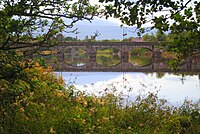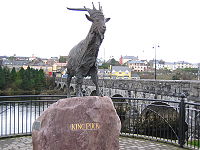Killorglin
| Killorglin Irish: Cill Orglan | |
| County Kerry | |
|---|---|
 Killorglin Town | |
| Location | |
| Grid reference: | V774965 |
| Location: | 52°6’23"N, 9°47’6"W |
| Data | |
| Population: | 2,163 (2022) |
| Local Government | |
Killorglin is a town in County Kerry, found 16 miles south of Tralee along the N70 road, and 14 miles west of Killarney along the N72 road. As of the 2022 census, the town's population was 2,163.
Killorglin is on the Ring of Kerry tourist route. Annual events here include the August Puck Fair festival, which starts with the crowning and parading of a "king" wild goat.[1]
History
The earliest evidence of ancient settlement in the Killorglin area is the presence of prehistoric rock art, examples of which occur in concentrations around the Iveragh and Dingle peninsulas, with a cluster close to the nearby town of Glenbeigh.[2] There are also a number of ringforts and early Christian ecclesiastical sites in the townlands of Dromavally and Castleconway.[3]
The ruins of Killorglin Castle, later known as Castle Conway, are located close to what is now the centre of the town. It was built in the early 13th century by Maurice FitzGerald, 2nd Lord of Offaly.[3]
The area was held by the FitzGerald dynasty until the confiscation of their lands following the Desmond Rebellions in the late 16th century. In 1587, as part of the Munster Plantation, Killorglin (and its castle) was granted to Captain Jenkin Conway.[4][5]

Much of the town centre was laid out in the 19th century.[4]
The Church of Ireland church was originally built in 1816 and significantly redeveloped in 1868.[4]
Killorglin's Roman Roman Catholic church was built (on the site of an earlier church) in 1891.[4]
The town hall was built in the early 20th century with the help of Andrew Carnegie.[6]
Abot the village
Killorglin is on the Wild Atlantic Way and Ring of Kerry tourist routes.[1] A visitor centre for the 'Reeks District' (a tourist area inspired by the nearby MacGillycuddy Reeks) is also located in the town.[7]
Culture
Puck Fair

Killorglin is known for the annual Puck Fair festival, which traditionally starts with the crowning of a "king" goat.[1] There is a large bronze King Puck statue on the edge of town close to the bridge. This statue was commissioned by the Killorglin Millennium Committee and designed by Valentia Island Sculptor Alan Ryan Hall. The King Puck Statue and Puck Garden was completed in 2001 and officially unveiled by Killorglin Lord Mayor Paudie Cronin and the Killorglin Millennium Committee.
In 2011, The Puck Poet plaques were added to the Puck Garden to recall some of the writers and poets who have written about Killorglin. These include Edso Crowley, Sigerson Clifford, Peter Joy and Johnny Patterson.
Music and events
Killorglin and its Puck Fair feature in a number of traditional Irish ballads and songs, including Bridget Donohue written by Johnny Patterson, King Puck by Christy Moore, and Wildflower of the Laune by Peter Joy.
A local tradition, Biddy's Day, occurs in the area during February. It involves groups, in traditional dress, visiting homes carrying a Brídeóg (or Biddy) effigy to ensure good luck.[8] In 2019, this Mid-Kerry practice was one of 30 "Intangible cultural heritage" traditions afforded recognition by the state.[9]
Literature
A number of books of local and national interest have been written about Killorglin and by Killorglin natives:
- Things My Mother Never Told Me (2003), by Blake Morrison, tells the story of the author's mother who was from Killorglin
- Cast A Laune Shadow (1997), by local historian Patrick (Pa) Houlihan (1918-2010), is a history of the town in story.
- Puck Fair"', by Michael Houlihan, is about the annual festival in August.
- "The Civil War in Kerry", by local historian Tom Doyle, details the part Kerry and Killorglin played in the Irish Civil War.
Sport
- Gaelic sports: Laune Rangers
- Rugby: Killorglin Rugby Club
- Football: Killorglin AFC
Outside links
| ("Wikimedia Commons" has material about Killorglin) |
References
- ↑ Bradley, R (1997). Signing the Land; Rock Art and the Prehistory of Atlantic Europe. London: Routledge.
- ↑ 3.0 3.1 The Iveragh peninsula: an archaeological survey of South Kerry. Cork University Press. 1996.
- ↑ 4.0 4.1 4.2 4.3 "Local Area Plans - Section 2 - Killorglin Local Area Plan". Kerry County Council. Archived from the original on 4 March 2016. https://web.archive.org/web/20160304031411/http://www.kerrycoco.ie/en/allservices/planning/planspolicies/localareaplans/killorglinfunctionalarealap/thefile%2C3385%2Cen.pdf.
- ↑ "Estate: Conway (Kerry)". Landed Estates Database. NUI Galway. http://landedestates.nuigalway.ie/LandedEstates/jsp/estate-show.jsp?id=1941. Retrieved 28 May 2021.
- ↑ Statement by Thomas O'Donnell (MP), The Irish People, 13 February. 1909, included in a report on Tower Model Village (County Cork)
- ↑ "Reeks District Visitor Information Centre". Go Kerry. http://www.gokerry.ie/reeks-district-visitor-information-centre/. Retrieved 18 April 2021.
- ↑ "Biddy's Day". Archived from the original on 22 January 2017. https://web.archive.org/web/20170122122224/http://biddysday.com/.
- ↑ "Mid-Kerry Biddy tradition gets official state recognition". The Kerryman. Independent News & Media. 27 July 2019. http://independent.ie/regionals/kerryman/news/midkerry-biddy-tradition-gets-official-state-recognition-38340351.html.
- Cill Orglan / Killorglin: Placenames Database of Ireland
